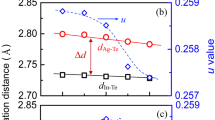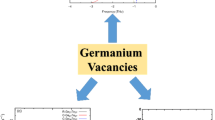Abstract
The two-dimensional (2D) structure often leads to unusual phenomena for the impact of confined mean free path of carrier scattering. As a quasi-2D layered material, AgCrSe2 has a liquid-like phonon behavior for its unstable Ag atoms at service temperature, leading to the promising candidate for thermoelectricity and fast ionic conductor. However, the inferior electronic performance constrains its application prospects as a functional semiconductor, which provides broad opportunity to tune its electric behaviors by defect chemistry. In this work, we revealed abundant electric transport behaviors of AgCrSe2 with different types of intrinsic defects. For example, the AgCrSe2 changes from Anderson insulator to metal when Se defects become prevailing and the magnetoresistance alters its sign depending on the relative ratio of Ag and Cr defects. Our results reported here can give salutary boosting on regulating the electric properties of ternary transition metal selenide by defect chemistry.

Similar content being viewed by others
References
Yuan H, Wang H, Cui Y. Acc Chem Res, 2015, 48: 81–90
Li B, Wang H, Kawakita Y, Zhang Q, Feygenson M, Yu HL, Wu D, Ohara K, Kikuchi T, Shibata K, Yamada T, Ning XK, Chen Y, He JQ, Vaknin D, Wu RQ, Nakajima K, Kanatzidis MG. Nat Mater, 2018, 17: 226–230
Van Der Lee A, Wiegers GA. J Solid State Chem, 1989, 82: 216–224
Gascoin F, Maignan A. Chem Mater, 2011, 23: 2510–2513
Ding J, Niedziela JL, Bansal D, Wang J, He X, May AF, Ehlers G, Abernathy DL, Said A, Alatas A, Ren Y, Arya G, Delaire O. Proc Natl Acad Sci USA, 2020, 117: 3930–3937
Wu D, Huang S, Feng D, Li B, Chen Y, Zhang J, He J. Phys Chem Chem Phys, 2016, 18: 23872–23878
Bhattacharya S, Basu R, Bhatt R, Singh A, Sen S, Aswal DK, Gupta SK. AIP Conf Proc, 2012, 1447: 1021–1022
Tang M, Chen Z, Yin C, Lin L, Ren D, Liu B, Kang B, Ang R. Appl Phys Lett, 2020, 116: 163901
Peng J, Liu Y, Pan Y, Wu J, Su Y, Guo Y, Wu X, Wu C, Xie Y. J Am Chem Soc, 2020, 142: 18645–18651
Bell LE. Science, 2008, 321: 1457–1461
Kim SI, Lee KH, Mun HA, Kim HS, Hwang SW, Roh JW, Yang DJ, Shin WH, Li XS, Lee YH, Snyder GJ, Kim SW. Science, 2015, 348: 109–114
Zhao LD, Tan G, Hao S, He J, Pei Y, Chi H, Wang H, Gong S, Xu H, Dravid VP, Uher C, Snyder GJ, Wolverton C, Kanatzidis MG. Science, 2016, 351: 141–144
Shi X, Chen L. Nat Mater, 2016, 15: 691–692
Liu Y, Zhou M, He J. Scripta Mater, 2016, 111: 39–43
Kimerling LC. MRS Bull, 1991, 16: 42–47
Tuller HL, Bishop SR. Annu Rev Mater Res, 2011, 41: 369–398
Wang H, Zhang J, Hang X, Zhang X, Xie J, Pan B, Xie Y. Angew Chem, 2015, 127: 1211–1215
Yano R, Sasagawa T. Cryst Growth Des, 2016, 16: 5618–5623
Bongers PF, Van Bruggen CF, Koopstra J, Omloo WPFAM, Wiegers GA, Jellinek F. J Phys Chem Solids, 1968, 29: 977–984
Damay F, Petit S, Rols S, Braendlein M, Daou R, Elkaïm E, Fauth F, Gascoin F, Martin C, Maignan A. Sci Rep, 2016, 6: 1–7
Engelsman FMR, Wiegers GA, Jellinek F, Van Laar B. J Solid State Chem, 1973, 6: 574–582
Gautam UK, Seshadri R, Vasudevan S, Maignan A. Solid State Commun, 2002, 122: 607–612
Gagor A, Pietraszko A, Gulay L. Int Union Crystallogr, 2012, 68: S239
Acknowledgements
This work was supported by the National Natural Science Foundation of China (U1832142), the National Key R&D Program of China (2018YFB0703602), the Youth Innovation Promotion Association CAS (Y202092), the Fundamental Research Funds for the Central University (WK2340000094), China Postdoctoral Science Foundation (2019TQ0293, 2020M671868), and the National Synchrotron Radiation Laboratory Joint funds of University of Science and Technology of China (KY2340000114).
Author information
Authors and Affiliations
Corresponding author
Ethics declarations
Conflict of interest The authors declare no conflict of interest.
Rights and permissions
About this article
Cite this article
Hua, Y., Bai, W., Wang, S. et al. Tuning the electric transport behavior of AgCrSe2 by intrinsic defects. Sci. China Chem. 64, 1970–1975 (2021). https://doi.org/10.1007/s11426-021-1071-4
Received:
Accepted:
Published:
Issue Date:
DOI: https://doi.org/10.1007/s11426-021-1071-4




